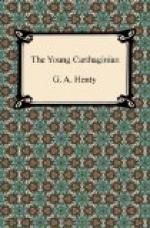As Malchus had seen the Iberian captives sent to labour as slaves in the mines in Spain, the fate thus announced to him did not appear surprising or barbarous. In those days captives taken in war were always made slaves when they were not put to death in cold blood, and although Hannibal had treated with marked humanity and leniency the Roman and Italian captives who had fallen into his hands, this had been the result of policy, and was by no means in accordance with the spirit in which war was then conducted. Accordingly, the next day the Carthaginians were, under a strong guard, marched away to the mines, which lay on the other side of the island, some forty miles due west of the port, and three miles from the western sea coast of the island. The road lay for some distance across a dead flat. The country was well cultivated and thickly studded with villages, for Rome drew a heavy tribute in corn annually from the island.
After twenty miles’ march they halted for the night, pursuing their way on the following morning. They had now entered a wide and fertile valley with lofty hills on either side. In some places there were stagnant marshes, and the officer in charge of the guard informed Malchus that in the autumn a pestilential miasma rose from these, rendering a sojourn in the valley fatal to the inhabitants of the mainland. The native people were wild and primitive in appearance, being clad chiefly in sheepskins. They lived in beehive shaped huts. The hills narrowed in towards the end of the day’s march, and the valley terminated when the party arrived within half a mile of their destination. Here stood a small town named Metalla, with a strong Roman garrison, which supplied guards over the slaves employed in working the mines. This town is now called Iglesias.
The principal mine was situated in a narrow valley running west from the town down to the sea coast. The officer in command of the escort handed over Malchus and his companions to the charge of the officer at the head mining establishment.
Malchus was surprised at the large number of people gathered at the spot. They lived for the most part in low huts constructed of boughs or sods, and ranged in lines at the bottom of the valley or along the lower slopes of the hill. A cordon of Roman sentries was placed along the crest of the hill at either side, and a strong guard was posted in a little camp in the centre of the valley, in readiness to put down any tumult which might arise.
The great majority of the slaves gathered there were Sards, men belonging to tribes which had risen in insurrection against the Romans. There were with them others of their countrymen who were not like them slaves, though their condition was but little better except that they received a nominal rate of payment. These were called free labourers, but their labour was as much forced as was that of the slaves — each district in the island being compelled to furnish a certain amount of labourers for this or the mines further to the north. The men so conscripted were changed once in six months. With the Sards were mingled people of many nations. Here were Sicilians and members of many Italian tribes conquered by the Romans, together with Gauls from the northern plains and from Marseilles.




